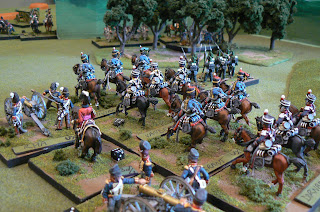Both Ney and the corps commander Gerard were well aware they were heavily outnumbered but were under orders to delay as much s possible the Allied advance. Gerard was at first prepared to defend the the small ridge north of the town of Renaix but seeing the Allied numbers especially in horse to his lone attached dragoon element (8 to 1) he abandoned that plan to then occupy the woods to the west of the town and the town itself to the east to anchor his defense and place his large artillery batteries between those terrain features to cover his centre.

Lord Hill, commanding the numerous Allied force made basically the same conclusion in observing the woods and town to be the main points of the French defence. As an assault of the centre would be deadly and overall he wanted to husband his troops for the further campaign, Hill placed the woods clearing to Stedman and his Dutch-Belgians. On the other flank, he sent Cole along with Kruse’s Nassauers to assault the town again hoping to push the French out of the feature and into the open fields beyond. With that, his British light horse would follow up the retreat to break the French.
As the Allied centre did not want to face the French artillery in the centre, The action was to be on each end of the battlefield. The Hanoverian brigade demonstrated the French firepower by coming within the French cannon range from its deployment to attack the town and paying the price, disintegrated forcing a command morale roll by Cole temporarily stopping his advance. He shifted the Nassau brigade out of range and had them follow his elite 27th Enniskillen Foot to the town.
In the usual vicious town fighting the Nassauers were heavily engaged and the 27th also hurt. In several hours the Allies were retreating from the town
On the other end of the battle, Stedman had entered the woods and was slowly working his Dutch-Belgians around the western end, but the Chasseurs collapsed against the experienced French Lights and his division fell back.
Now Hill was forced to change his dispositions, moving Colville to replace Stedman while Colville’s artillery useless against firing into the woods, moved to the front. Hill also ordered the Duke of Brunswick to move his ‘corps’ to help Cole to secure the town while he moved to help Colville and his command. Like Wellington, he needed to be everywhere.
Perhaps seeing the redcoats cresting the hill or feeling safety from the French, the Dutch-Belgians regain their composure (my roll of a 6 had them fully recovered from that unfortunate corps morale roll previously!)
Cole’s assault on Renaix failed and around noon, many journals of the battle would recall the strange silence over the battlefield. No guns fired, no masses of troops moved.
Hill, seeing Cole’s lost effort against the town and Stedman’s weak division holding the flanks, the French still happily in position, pondered if fresh attacks would merely squander his force.
On the other side, Gerald, on the left and behind the woods wondered why the silence while Ney on the right pursued his debate whether to hold the town or retreat intact.
Both sides in their debates asked if a further clash would serve their campaign victory further when a lone Enniskillen officer shouted, “That’s enough going back, lads!” and the regiment abruptly turned around to once again face the enemy. ( I rolled the miracle 6 on the dice once again!)
Hill upon seeing that all was not lost, again ordered adjustments in his tactics for further attacks.
He move the horse artillery to start a bombardment of the town and caused the remaining French formation to abandon the town as fires were ignited.
On the right, western flank, Stedman started successfully to envelope the French far flank, as Colville’s impressive column moved to the woods. While his corps morale held, Gerard knew his time was limited. he had not the troops to cover his right as the town that was his anchor will soon be taken and his overall positions would be overrun. Surprisingly Ney suggested the withdrawal. So after five hours of fighting, Gerard called for the retreat and all his units started to move to his LOC ( the optional rule offers a “retreat order” which does not count PiPs command points but does not allow artillery fire or strong fighting. The opponents must still roll for command but for any light horse) But with this, the Allies had a big advantage in light horse, but seemingly caught off-guard by the precipitous French withdrawal, the previously idle Allied light horse stationed in the centre of the Allied line for this purpose, could not quite catch the French as they exited the table…. merely the mathematics of distance and the measuring stick.

However the pursuit continued with a few batteries of Royal Horse Artillery adding effect to any squares forming to ward off the British hussars but this practice ended when the French dragoons stopped to lend assistance. Nevertheless the French retreat did not stop until they returned to Leuze late in the day.
While the Allies had a huge 23 to 7 element advantage, most divisions including the D-B horse and Colville’s divisions were not in the action and overall casualties were light. However while Gerard accomplished his starting goals, the Allies would claim victory in this, the third of the 2nd Day battles of the 100.5 Day campaign.